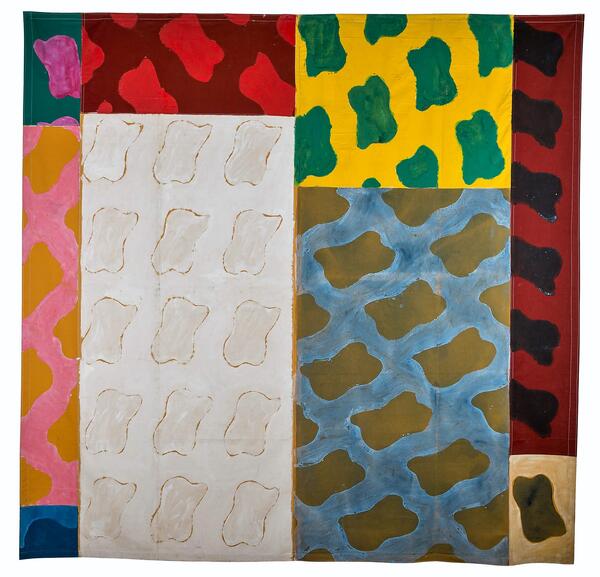Claude Viallat is a French painter born in 1936 in Nîmes, in the south of France. He studied at the École des Beaux-Arts in Paris, but his painting style was largely influenced by the New York School associated with Abstract Expressionism and the essays of the art critic Clement Greenberg. Greenberg believed that flatness and lack of depth were important characteristics of abstract paintings.
Claude Viallat created the untitled painting from the collection of the Ludwig Museum in 1978. The picture was created in the later period of the artist’s career; it provides insight into Viallat’s main ideas regarding the art of painting.
Claude Viallat never made any changes to the composition and geometric figure. The artist experimented only with the color and size of objects, and he paid great attention to the background. The work from the museum’s exhibition is a rectangular canvas with a painted pattern.
Viallat filled the entire pictorial space with rectangles. He divided the canvas into zones — vertical or horizontal, wide or narrow, long or short. They differ in color palette and the angle at which the pattern is inclined. Viallat used this technique to create the rhythm of the picture.
The artist has been experimenting with color and shape at all stages of his work. This was his way to find a new definition of art. Viallat often used prints or stencils, but the picture from the exhibition was painted with acrylic on canvas.
Back in the late 1960s, Viallat, together with other French painters, founded the “Supports/Surfaces” association. The group wanted to establish a new vision of art. According to these painters, the artist seized to be being the key figure in painting. The focus was on the collective consciousness that revealed itself on the canvas.
The first solo exhibition of Claude Viallat took place in Nice in the gallery “A” in 1966. Three years later, he showed his work in the capital, in Jean Fournier Gallery in Paris. The artist collaborated with the gallery for the next 30 years.
In 1979, Claude Viallat became director of the School of Fine Arts in Nîmes. Now the artist lives in his hometown, continues to paint and teach.
Claude Viallat created the untitled painting from the collection of the Ludwig Museum in 1978. The picture was created in the later period of the artist’s career; it provides insight into Viallat’s main ideas regarding the art of painting.
Claude Viallat never made any changes to the composition and geometric figure. The artist experimented only with the color and size of objects, and he paid great attention to the background. The work from the museum’s exhibition is a rectangular canvas with a painted pattern.
Viallat filled the entire pictorial space with rectangles. He divided the canvas into zones — vertical or horizontal, wide or narrow, long or short. They differ in color palette and the angle at which the pattern is inclined. Viallat used this technique to create the rhythm of the picture.
The artist has been experimenting with color and shape at all stages of his work. This was his way to find a new definition of art. Viallat often used prints or stencils, but the picture from the exhibition was painted with acrylic on canvas.
Back in the late 1960s, Viallat, together with other French painters, founded the “Supports/Surfaces” association. The group wanted to establish a new vision of art. According to these painters, the artist seized to be being the key figure in painting. The focus was on the collective consciousness that revealed itself on the canvas.
The first solo exhibition of Claude Viallat took place in Nice in the gallery “A” in 1966. Three years later, he showed his work in the capital, in Jean Fournier Gallery in Paris. The artist collaborated with the gallery for the next 30 years.
In 1979, Claude Viallat became director of the School of Fine Arts in Nîmes. Now the artist lives in his hometown, continues to paint and teach.



